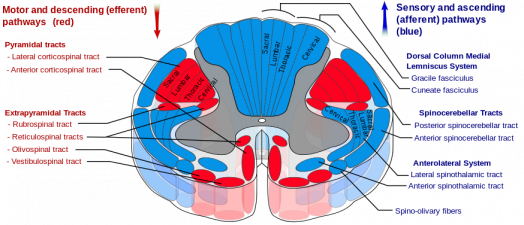Spinothalamic tract: Difference between revisions
No edit summary |
No edit summary |
||
| Line 5: | Line 5: | ||
</div> | </div> | ||
== Description == | == Description == | ||
The corticospinal tract is one of the several ascending neural pathways which lies anteriolaterally to the ventral horn of the spinal grey matter. This pathway comprises of three neutron sets. | The corticospinal tract is one of the several ascending afferent neural pathways which lies anteriolaterally to the ventral horn of the spinal grey matter. This pathway comprises of three neutron sets. | ||
[[File:Spinal cord cross section.png|center|frameless|524x524px]] | |||
====== '''1st Order Neurones''' ====== | ====== '''1st Order Neurones''' ====== | ||
| Line 13: | Line 15: | ||
====== '''2nd Order Neurones''' ====== | ====== '''2nd Order Neurones''' ====== | ||
== | The cell bodies of the second order neurones lie within the posterior grey horn of the spinal cord. Once the second order neurones have synapsed with the first order neurones, they decussate via the ventral commissar at their respective segmental level. The second order neurones now ascend up the spinal cord anteriolaterally now known as the spinothalamic tract - those neurones from the lower spinal cord are more dorsal and lateral while the more rostral levels are ventral and medial. As it enters the region of the head it is joined by the trigeminal afferents as well as accompanying the medial lemniscus pathway. The second order neurones then synapse with the third order neurones in the ventral posterior nucleus of the thalamus. | ||
====== '''3rd Order Neurones''' ====== | |||
The third order neurones then project from the thalamus to the primary somatosensory cortex (Brodman areas 3, 1 and 2) | |||
== | == Function == | ||
== Clinical relevance == | == Clinical relevance == | ||
Revision as of 11:27, 27 July 2018
Original Editor - name here
Top Contributors - Matt Ross, Kate Sampson, Aminat Abolade, Kim Jackson, Amanda Ager, Lucinda hampton and WikiSysop
Description[edit | edit source]
The corticospinal tract is one of the several ascending afferent neural pathways which lies anteriolaterally to the ventral horn of the spinal grey matter. This pathway comprises of three neutron sets.
1st Order Neurones[edit | edit source]
These neurones carry information regarding pain, thermal sensation, course touch and pressure. These primary afferent neurones, also known as nociceptive neurones (read more about nociception), are specialised neurones that can be divided into 4 main modalities; mechanonociceptors (Pressure), Thermal Nociceptors, Chemically sensitive nociceptors or polymodal nociceptors. Their cell bodies reside in the dorsal root ganglion, and synapse onto second order neurones located within the posterior grey horn of the spinal cord.
2nd Order Neurones[edit | edit source]
The cell bodies of the second order neurones lie within the posterior grey horn of the spinal cord. Once the second order neurones have synapsed with the first order neurones, they decussate via the ventral commissar at their respective segmental level. The second order neurones now ascend up the spinal cord anteriolaterally now known as the spinothalamic tract - those neurones from the lower spinal cord are more dorsal and lateral while the more rostral levels are ventral and medial. As it enters the region of the head it is joined by the trigeminal afferents as well as accompanying the medial lemniscus pathway. The second order neurones then synapse with the third order neurones in the ventral posterior nucleus of the thalamus.
3rd Order Neurones[edit | edit source]
The third order neurones then project from the thalamus to the primary somatosensory cortex (Brodman areas 3, 1 and 2)







